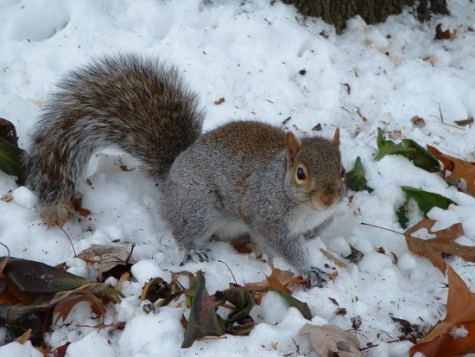A rare squirrel was found preserved under ice Tuesday afternoon in the back of Gardner Hall, leading to the ENC biology department hypothesizing a new scientific theory of hibernation.
Kept fully intact buried under three feet of snow, this creature was discovered by freshman Robert Lindmeier as he worked on removing the snow from our sidewalks.

Due to the graphic nature of the frozen dead squirrel, a different live squirrel amongst the snow and brush is pictured here.
“I hit a large block of ice and didn’t know what to do with it,” said Lindmeier.
Upon his discovery, Lindmeier immediately called Facilities Manager Dale Vasconcellos who excavated the squirrel carefully.
There was an expectation that the squirrel could regain consciousness because of the hibernation theory, so the team spent over an hour meticulously brushing snow away from the squirrel.
Squirrels flit around campus, but rarely are still for long enough to be examined.
“As soon as I saw a tail, I panicked!” Lindmeier recalls with excitement. “I just didn’t think anything like this was possible.”
Department Chair of Biology Professor Jonathan Twining commented that it is possible for animals to freeze completely under certain conditions.
Twining theorizes a new mechanism of hibernation due to the drastic change in weather this winter.
As a result of the excessive amounts of snowfall, squirrels have adapted to survive. This new mechanism allows them to “freeze” in the bone-chilling temperatures of winter. This process has already been observed occurring in some amphibians.
“A chemical called Ethylene Glycol is found in [the squirrel’s] blood stream, and effectively allows their body to freeze while keeping the flow of blood to vital organs,” explains Twinning.
As temperatures increase in the spring, the squirrel’s body is expected to thaw out and walk away unharmed. The squirrel found on campus, however, did not survive after it was taken to the Biology department; students worked closely to bring the squirrel back to life.
Twining and other professors are working t0 find out more about this evolutionary discovery, and why this particular squirrel did not thaw properly.
When asked if he believes there are more hidden treasures under the piles of snow, the professor smiles.
“The chances of finding another one of these are one in a million! We were really lucky.”

